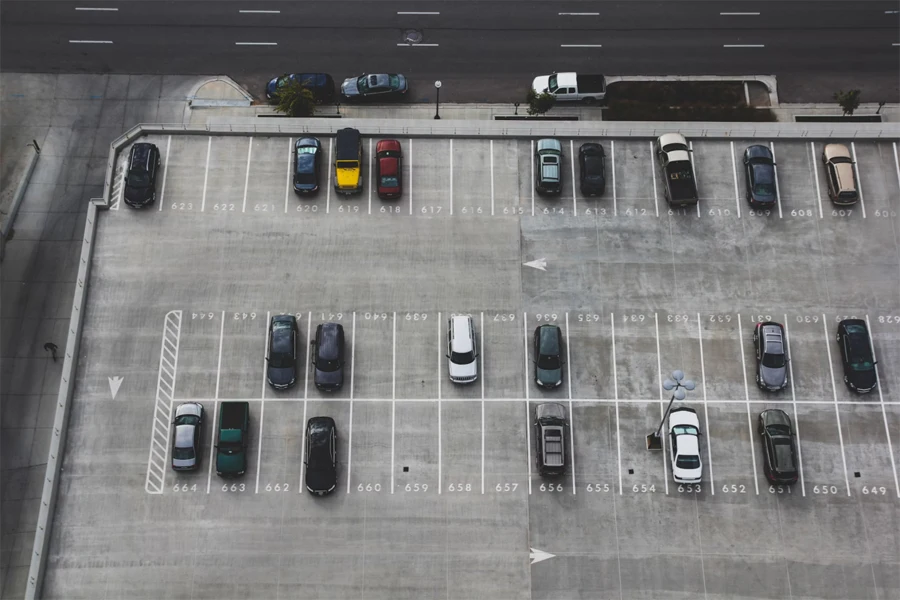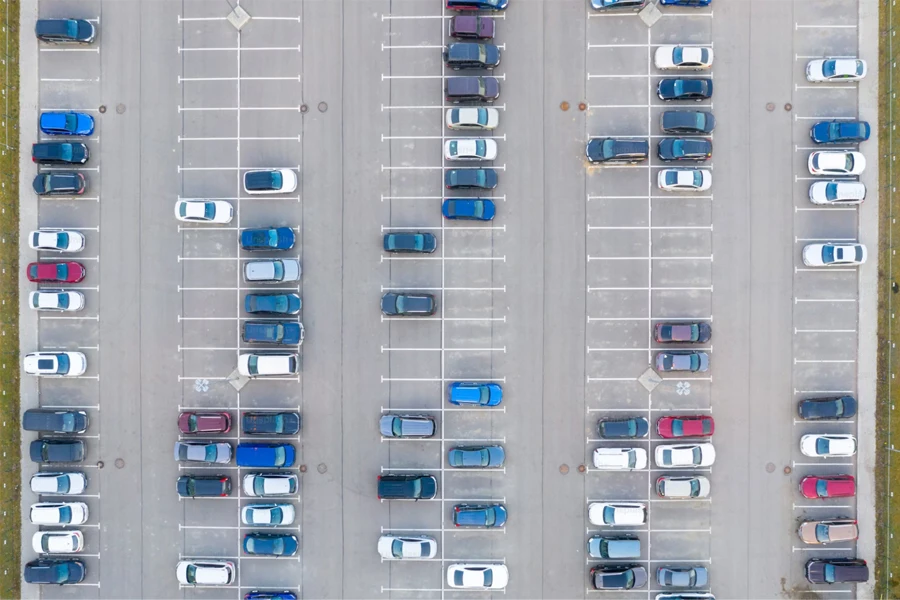Table of Contents
1. Introduction
2. Exploring the types and uses of parking equipment
3. Current market trends and insights
4. Essential factors for selecting parking equipment
5. Top models and standout features
6. Conclusion
Introduction
Choosing the appropriate parking equipment in 2024 is the right move toward developing the parking structures for any business. It is a subsystem of parking systems that deal with EV charging, smart parking sensors, and MaaS platforms, which enhance efficiency and client satisfaction. High technologies such as IoT and dynamic pricing allow for receiving live information and enabling automatic control over spaces and income. Given the increased focus on smart, efficient, and eco-friendly parking solutions, companies should seek to provide more such facilities, enhancing customer satisfaction and commitment.
Exploring the types and uses of parking equipment

Embracing electric vehicle (EV) charging stations
Today, EV charging stations are essential in every parking facility. Given the global effort towards achieving sustainable energy sources and coming-of-age electric vehicles, investors in the business and public domains are putting their money into this type of infrastructure. By examining recent tendencies of EV charging stations, it can be stated that they are requested by consumers and supported by government measures worldwide. These stations do more than serve the increasing demand of users of EVs; they also increase the appeal of parking structures. Installing charging stations is considered a progressive action through which businesses can be perceived as socially conscious, thus attracting customers and adding to revenues.
Smart parking sensors and IoT: Revolutionizing efficiency
Smart parking sensors and the Internet of Things technology have emerged as the future of parking systems. These enhanced sensors offer real-time data about the availability of the parking spaces, hence the specific space management. Smart sensors also help manage available space and enforce appropriate parking rules, thus eliminating overcrowding. Breaking down the communication between the sensors and the managerial structures in IoT allows automatic enforcement and improved usage of available resources. This reduces operation costs dramatically while at the same time enhancing the satisfaction of the users because they can search for available parking spaces.
Mobility-as-a-service (MaaS) platforms: Seamless integration
MaaS options have introduced a new shift in the style of parking services. These integrated mobile solutions let users book and pay for parking by the mobile application and get access to other services, including valet, charging for electric vehicles, and washing cars. With the help of harmonizing multiple transport services that can be delivered through MaaS, the overall parking experience improves, and parking operators gain extra revenues. Another advantage of such platforms is that these services can accommodate dynamic pricing with the ability to change the rates to generate maximal revenues dynamically. Firstly, integrating MaaS platforms into the existing parking solutions allows for covering the new needs of consumers.
Micro Mobility parking: Adapting to new trends
Micro-mobility vehicles are relatively new in the market and include electric scooters and bicycles, and since people use these cars for transport, they require places to park them. They are quite useful when large congestion and crowded urban areas need to be navigated, and they are presented as a more friendly solution to the environment. The government has to factor in the fact that spaces to park these vehicles should be provided due to the increasing population in the market for these micro-mobility vehicles. These parking solutions are both effective in the fight for sustainable urban mobility and contribute to eliminating clutter and increasing safety due to properly organized and safeguarded parking places. Investing in micro-mobility parking infrastructure means providing innovations and ensuring ecologically friendly car parking areas, thus gaining in the consumer audience and popularity.
Current market trends and insights

Market surge and emerging trends
An increase in the market for parking equipment has been experienced. The change is brought about by technological advancements and the client’s needs. From the current market analysis, it has been estimated that the parking management solution market at the global level shall continue to show significant growth and ascend to new levels by 2025. The development is driven by using and applying smart parking solutions, EV charging networks, and new mobility services. The gradual increase in demand for parking space has contributed to the use of these technologies in urban and non-urban parking areas on a global scale. Such a pattern suggests a healthy future market line and reveals great chances to foster ground-breaking parking services in the business sphere.
Analysts estimate the parking management market will be at US $4.4 billion in 2023. They anticipate it will reach US $6.3% by 2028, growing at a CAGR of 7.4% in the forecast period.
The hybrid work shift: Changing parking dynamics
Due to the change to hybrid work models, parking dynamics have been significantly influenced. An increased number of employees are working remotely, which has decreased the demand for standard monthly parking passes. Instead, there is a contemporary requirement for elastic parking opportunities that can manage the irregulated work schedules of the modern employee. An investigation carried out on parking usage reflects that this is in the middle of the week from Tuesday to Thursday, and low parking usage is on Mondays and Fridays. This change requires reconsideration of certain tactics for handling parking lots to avoid excess or shortage of space. It is hoped that flexible parking packages and the use of information technologies, which allow one to make a booking or pay for parking by phone, correlate with the new patterns of work.
Electric vehicle boom: Powering up infrastructure
The demand for electric vehicles is rising rapidly, causing a direct effect on the EV charging stations Market. Current trends also reveal that there has been an uptrend in the sale of EVs, and the statistics suggest that more EVs are expected to be on the road in the subsequent years. This increase requires the scaling up of charges that come with electric vehicles to pave the way for many charging stations for EVs. Regarding the investment in charging infrastructure, it is necessary to state that it meets the requirements of current regulations and improves the satisfaction of customers by completing vital services. The organizations that implement EV chargers can thus entice more customers, show concern for environmental conservation, and take advantage of the expanding market of green mobility solutions.
Essential factors for selecting parking equipment

Assessing needs: Present and future
The most important aspect one must consider when procuring parking equipment is comprehending the specific requirements. Every facility is different due to location, size, and types of users that the facility serves. The use patterns of the current state define the immediate requirements, such as the number of parking bays, the kind of automobile, and the busy hours. But, it’s equally important to ensure that one is prepared to respond to future demand. As with most industries, the selection criteria should consider other variables, such as the current trend, like the proliferation of EVs and issues with patterns of work. All these help not to go for too many upgrades and extra expenses.
Tech integration: Staying ahead of the curve
Adding new technologies in the management of parking lots has many benefits. Smart parking sensors and IoT devices ensure real-time information on the availability of parking spaces and direct drivers to such spaces for efficient operation. Sophisticated MaaS contains other related services, such as payment, booking, and supplementary services like valet and car washing services. Not only does this enhance customer satisfaction, but it also eliminates manual interference in operation. Advancements in technology and the general uptake of creativity allow parking facilities to accommodate changes in users’ expectations.
Cost vs. ROI: Smart investment strategies
Expenses and returns on investment are the next steps in the decision-making process. The initial costs of putting up and improving new parking equipment are quite expensive. However, it is not always bad news since the returns of such investment outweigh the costs most of the time. For instance, charging stations provide more customer traffic and can generate other sales. Automated smart parking systems minimize their operational costs and maximize the space, which, in the long run, results in efficiency and customer satisfaction. It enables decision-makers to determine likely returns on their investment before continuing to enhance retention policies so that the investment not only meets present wants but, more significantly, offers considerable returns in the future.
Flexibility and scalability: Future-proofing investments
The ability of parking equipment to be flexible and scalable is important. The selected systems should be able to integrate, modify, and adapt to different innovations in the contexts of technology and usage. For instance, with the emergence of a new form, such as micromobility, new structures must be put in place to support the provision of parking facilities for bicycles and electric scooters in addition to conventional automobiles. Controllable solutions can also be extended or modified to meet the increasing demand without drastic changes. Purchasing infrastructure to support new features and technologies as they come to the market proves useful in maintaining operational efficiency and addressing future wants.
Green choices: Prioritizing sustainability
Environmental concerns are becoming more critical when choosing parking equipment. All energy-efficient charging stations, lights, and other features are environmentally friendly and pull the string of environmentally conscious consumers. The use of green technologies is also cyclical with the regulations and the corporate social responsibility agendas. Furthermore, the sustainable practices adopted in the facility help to advertise the facility as a flare among many users. Sustainability leads to conserving the environment while creating value for businesses since the latter would experience long-term cost efficiencies.
Spotlight on top cat trees and scratching posts of 2024

Leading models and their features
The cat trees and scratching posts market 2024 includes several excellent models created to satisfy various requirements. There are two outstanding ones: The Refined Feline Lotus Cat Tower and the PetFusion Ultimate Cat Scratcher Lounge.
The Refined Feline Lotus Cat Tower is a mix of aesthetics and functionality. This tower has a height of 69 inches and consists of 4 tiers of platforms, all of which are fitted with a comfortable and easy-to-clean Berber carpet made for cats. There is a sisal scratching pad to enhance the health of cats’ claws and a cushioned hideaway for cats to rest. Its construction makes it more durable from the solid wood that warrants an investment for people who own pets and want to decorate their homes in style.
The PetFusion ultimate cat scratcher lounge is rather useful and not very spectacular in its look product. This scratcher lounge is made from recycled corrugated cardboard and is a green product, thus selling well to conservationists. Measuring 34 x 10. 5 x 10. Measuring 5 inches allows cats to find space to play, scratch, and sleep. The reversible design means that it can be used twice as long as if it were one-sided. Thus, it will last longer. The materials used in making natural and non-toxic cat scratchers and their construction make them suitable for handling cat’s aggressive scratches. The non-hybrid model in the series sells between $50 and $70, depending on the model and year of production.
Comparative analysis of best models

Features and functionalities
Electric Vehicle (EV) Charging Stations: Innovative to today’s parking needs, EV charging stations are required for the growing number of electric cars on the market. For instance, the ChargePoint Home Flex has a power output beyond 50 amps and works both for indoor and outdoor settings. It can charge relatively faster and suits most electric cars, which is why it is popular. The self-installation wall connector offers charging within homes, and with ranges of up to 44 miles per hour, the wall connector is preferred by many Tesla car users.
Smart Parking Sensors and IoT Integration: They are changing how parking spaces are handled. Companies like ParkHelp have smart parking sensors that provide live information about the parking spaces’ availability and direct the drivers to the available parking space. IoT integration guarantees the proper exchange of information between parking systems and associated mobile applications to optimize the user experience. For instance, IoT in the ParqEx system offers a chance to access availability and make a reservation instantly, optimizing the parking process.
Parking Guidance Systems: Using such systems as those of Indect, drivers are well-directed on where and when to park, thereby saving much time that would otherwise be spent on the search. Indect’s ultrasonic sensors and guidance displays are posted in parking facilities to give drivers directions to parking spaces. The given technology enhances the satisfaction level of the users and optimizes the lot occupancy simultaneously.
Parking Access and Revenue Control (PARC) Systems: The PARC systems used in FlashParking are compatible with mobile payment systems, making them more reliable for operators and convenient for consumers. Such systems include some processes, such as ticketing through an app, the ability to pay via mobile, and comprehensive statistics on parking. Employing such highly developed systems, the given facilities can enhance several spheres, including revenue processes.
Automated Parking Systems: These systems, such as those used by Skyline Parking, use automated machinery to park the cars in tight formations. This technology optimizes the parking space, making it safe and convenient for clients to park their vehicles. PTC’s systems can accommodate 60 cars per hour, so parking structures’ throughputs will be greatly enhanced.
Usage scenarios
Commercial Complexes: EV charging stations and smart parking sensors can greatly improve the client experience for large commercial zones. Additionally, ChargePoint Home Flex stations and ParkHelp sensors can minimize factors such as stress and dissatisfaction regarding EV charging for customers.
Residential Areas: In residential sectors, Tesla Wall Connectors deliver powerful and fast charging to the owners of electric vehicles. There are also smart parking sensors, such as ParqEx, to organize guest parking and guarantee residents access to their parking slots.
Urban Centers: Cities especially stand to gain a lot from parking guidance systems and automated car parking. Indect’s guidance systems traffic can help to decrease congestion by leading drivers to available places as soon as possible; Skyline Parking’s automated systems ensure effective use of spaces for the densely-populated areas, thus offering a solution for the parking problems of cities.
Airports and Transportation Hubs: PARC systems of FlashParking allow for the optimization of airports and other transportation facilities with a focus on safety. Such systems handle many vehicles efficiently and offer self-service ticketing and payment systems, making them faster and more secure.
Retail Centers: Retail centers can use EV charging stations, smart sensors, and PARC systems to make parking easy and convenient. With ChargePoint stations, shoppers can charge their vehicles while they shop, and with smart sensors combined with PARC systems from FlashParking, it is easy for them to navigate and make secure payments.

Conclusion
Selecting the most appropriate parking equipment in 2024 is a key factor in improving the operations and user experience. Applying new-generation systems like charging stations for EVs, smart parking sensors, and other robotic systems guarantees that the infrastructure meets the requirements. As the global demand for parking management progresses, especially for ChargePoint Home Flex, ParkHelp sensors, Indect guidance systems, and FlashParking PARC systems, investing in innovative parking management solutions will enhance the space’s efficient use. This will not only cut costs but also add to revenues. Maintaining the competitive advantage with these top models is possible, which responds to the requirements of the new urban scenario and will grow sustainably.




